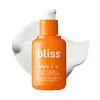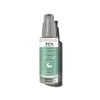What's inside
What's inside
 Key Ingredients
Key Ingredients

 Benefits
Benefits

 Concerns
Concerns

 Ingredients Side-by-side
Ingredients Side-by-side

Water
Skin ConditioningGlycerin
Humectant3-O-Ethyl Ascorbic Acid
Skin ConditioningPropanediol
SolventPalmitoyl Tripeptide-5
Skin ConditioningSodium Hyaluronate
HumectantTocopherol
AntioxidantGlycyrrhiza Glabra Root Extract
BleachingPseudozyma Epicola/Camellia Japonica Seed Oil Ferment Extract Filtrate
Emulsion StabilisingCamellia Sinensis Seed Oil
HumectantGlucose
HumectantBisabolol
MaskingSqualane
EmollientHydrogenated Farnesene
EmollientHydroxyethyl Acrylate/Sodium Acryloyldimethyl Taurate Copolymer
Emulsion StabilisingC14-22 Alcohols
Emulsion StabilisingPolyacrylate Crosspolymer-6
Emulsion StabilisingSodium Citrate
BufferingC12-20 Alkyl Glucoside
EmulsifyingXanthan Gum
EmulsifyingCitric Acid
BufferingDimethyl Isosorbide
SolventEthoxydiglycol
HumectantGlyceryl Stearate
EmollientHydroxyacetophenone
AntioxidantTetrasodium Glutamate Diacetate
Caprylyl Glycol
EmollientPolyglyceryl-4 Laurate/Succinate
Ethylhexylglycerin
Skin ConditioningAcacia Senegal Gum
MaskingLecithin
EmollientSclerotium Gum
Emulsion StabilisingPullulan
Hexylene Glycol
EmulsifyingPhenoxyethanol
PreservativeParfum
MaskingLimonene
PerfumingWater, Glycerin, 3-O-Ethyl Ascorbic Acid, Propanediol, Palmitoyl Tripeptide-5, Sodium Hyaluronate, Tocopherol, Glycyrrhiza Glabra Root Extract, Pseudozyma Epicola/Camellia Japonica Seed Oil Ferment Extract Filtrate, Camellia Sinensis Seed Oil, Glucose, Bisabolol, Squalane, Hydrogenated Farnesene, Hydroxyethyl Acrylate/Sodium Acryloyldimethyl Taurate Copolymer, C14-22 Alcohols, Polyacrylate Crosspolymer-6, Sodium Citrate, C12-20 Alkyl Glucoside, Xanthan Gum, Citric Acid, Dimethyl Isosorbide, Ethoxydiglycol, Glyceryl Stearate, Hydroxyacetophenone, Tetrasodium Glutamate Diacetate, Caprylyl Glycol, Polyglyceryl-4 Laurate/Succinate, Ethylhexylglycerin, Acacia Senegal Gum, Lecithin, Sclerotium Gum, Pullulan, Hexylene Glycol, Phenoxyethanol, Parfum, Limonene
Water
Skin ConditioningCaprylic/Capric Triglyceride
MaskingGlycerin
HumectantPropanediol
SolventCoco-Caprylate/Caprate
EmollientSqualane
EmollientCetyl Alcohol
EmollientCetyl Phosphate
EmulsifyingCrambe Abyssinica Seed Oil
Skin ConditioningArginine
MaskingGlycine Soja Oil
EmollientGlyceryl Stearate
EmollientPhenoxyethanol
PreservativeSodium Dehydroacetate
PreservativeEthylhexylglycerin
Skin ConditioningInulin
Skin ConditioningVaccinium Vitis-Idaea Seed Oil
AntioxidantSclerotium Gum
Emulsion StabilisingTocopherol
AntioxidantSodium Hyaluronate
HumectantAlbatrellus Confluens Extract
HumectantAlpha-Glucan Oligosaccharide
CleansingXanthan Gum
EmulsifyingSodium Carboxymethyl Betaglucan
Biosaccharide Gum-4
Skin ConditioningLaminaria Ochroleuca Extract
Skin ConditioningCitrus Aurantium Amara Flower Extract
RefreshingBeta-Carotene
Skin ConditioningXanthophylls
Skin ConditioningHelianthus Annuus Seed Oil
EmollientRosmarinus Officinalis Leaf Extract
AntimicrobialCitric Acid
BufferingLactic Acid
BufferingSodium Hydroxide
BufferingGeraniol
PerfumingLinalool
PerfumingWater, Caprylic/Capric Triglyceride, Glycerin, Propanediol, Coco-Caprylate/Caprate, Squalane, Cetyl Alcohol, Cetyl Phosphate, Crambe Abyssinica Seed Oil, Arginine, Glycine Soja Oil, Glyceryl Stearate, Phenoxyethanol, Sodium Dehydroacetate, Ethylhexylglycerin, Inulin, Vaccinium Vitis-Idaea Seed Oil, Sclerotium Gum, Tocopherol, Sodium Hyaluronate, Albatrellus Confluens Extract, Alpha-Glucan Oligosaccharide, Xanthan Gum, Sodium Carboxymethyl Betaglucan, Biosaccharide Gum-4, Laminaria Ochroleuca Extract, Citrus Aurantium Amara Flower Extract, Beta-Carotene, Xanthophylls, Helianthus Annuus Seed Oil, Rosmarinus Officinalis Leaf Extract, Citric Acid, Lactic Acid, Sodium Hydroxide, Geraniol, Linalool
Ingredients Explained
These ingredients are found in both products.
Ingredients higher up in an ingredient list are typically present in a larger amount.
Citric Acid is an alpha hydroxy acid (AHA) naturally found in citrus fruits like oranges, lemons, and limes.
Like other AHAs, citric acid can exfoliate skin by breaking down the bonds that hold dead skin cells together. This helps reveal smoother and brighter skin underneath.
However, this exfoliating effect only happens at high concentrations (20%) which can be hard to find in cosmetic products.
Due to this, citric acid is usually included in small amounts as a pH adjuster. This helps keep products slightly more acidic and compatible with skin's natural pH.
In skincare formulas, citric acid can:
While it can provide some skin benefits, research shows lactic acid and glycolic acid are generally more effective and less irritating exfoliants.
Most citric acid used in skincare today is made by fermenting sugars (usually from molasses). This synthetic version is identical to the natural citrus form but easier to stabilize and use in formulations.
Read more about some other popular AHA's here:
Learn more about Citric AcidEthylhexylglycerin (we can't pronounce this either) is commonly used as a preservative and skin softener. It is derived from glyceryl.
You might see Ethylhexylglycerin often paired with other preservatives such as phenoxyethanol. Ethylhexylglycerin has been found to increase the effectiveness of these other preservatives.
Glycerin is already naturally found in your skin. It helps moisturize and protect your skin.
A study from 2016 found glycerin to be more effective as a humectant than AHAs and hyaluronic acid.
As a humectant, it helps the skin stay hydrated by pulling moisture to your skin. The low molecular weight of glycerin allows it to pull moisture into the deeper layers of your skin.
Hydrated skin improves your skin barrier; Your skin barrier helps protect against irritants and bacteria.
Glycerin has also been found to have antimicrobial and antiviral properties. Due to these properties, glycerin is often used in wound and burn treatments.
In cosmetics, glycerin is usually derived from plants such as soybean or palm. However, it can also be sourced from animals, such as tallow or animal fat.
This ingredient is organic, colorless, odorless, and non-toxic.
Glycerin is the name for this ingredient in American English. British English uses Glycerol/Glycerine.
Learn more about GlycerinGlyceryl Stearate is a mix of glycerin and stearic acid.
It is used to stabilize the mixing of water and oil ingredients. By preventing these ingredients from separating, it can help elongate shelf life. It can also help thicken the product's texture.
As an emollient, it helps soften skin and supports barrier-replenishing ingredients.
In cosmetics, Glyceryl Stearate is often made from vegetable oils or synthetically produced.
This ingredient may not be fungal-acne safe
Fun fact: The human body also creates Glyceryl Stearate naturally.
Learn more about Glyceryl StearatePhenoxyethanol is a preservative that has germicide, antimicrobial, and aromatic properties. Studies show that phenoxyethanol can prevent microbial growth. By itself, it has a scent that is similar to that of a rose.
It's often used in formulations along with Caprylyl Glycol to preserve the shelf life of products.
Propanediol is an all-star ingredient. It softens, hydrates, and smooths the skin.
It’s often used to:
Propanediol is not likely to cause sensitivity and considered safe to use. It is derived from corn or petroleum with a clear color and no scent.
Learn more about PropanediolSclerotium Gum is a polysaccharide gum made by the fungus, Sclerotium rolfssii. It is similar to xanthan gum.
In cosmetics, Sclerotium Gum is used to thicken the texture and to help stabilize other ingredients.
As an emulsifier, Sclerotium Gum helps prevent ingredients from separating, such as water and oil.
Learn more about Sclerotium GumSodium Hyaluronate is hyaluronic acid's salt form. It is commonly derived from the sodium salt of hyaluronic acid.
Like hyaluronic acid, it is great at holding water and acts as a humectant. This makes it a great skin hydrating ingredient.
Sodium Hyaluronate is naturally occurring in our bodies and is mostly found in eye fluid and joints.
These are some other common types of Hyaluronic Acid:
Learn more about Sodium HyaluronateSqualane is an emollient that helps the skin hold onto moisture. It's an oily liquid that occurs naturally in certain types of fish and plant oils.
Because squalane boosts hydration in the skin, it also comes with plenty of benefits: it is an antioxidant and can help fight free radicals and skin damage. Squalane is also found to have a detoxifying effect when applied.
Squalane comes from squalene, which occurs naturally within the sebum of our skin. It is one of the oils our skin produces to keep itself hydrated. Squalane is the hydrogenated version of squalene and has a longer shelf life.
Research shows that squalane is non-irritating (even at 100% concentration).
In general, it's a fantastic ingredient. It does a great job at hydrating the skin, and it's suitable for those with sensitive skin.
The source of squalane may impact malassezia / fungal acne. This is because olive oil derived squalane can contain impurities such as fatty acids and plant waxes. Sugarcane derived squalane is recommended for anyone with malassezia concerns.
Is squalane vegan?
This depends on the source. Squalane can be derived from both plants and animals. Most squalane used in skincare comes from plants.
Please note: the source of squalane is only known if disclosed by the brand. We recommend reaching out to the brand if you have any questions about their squalane.
Read more about squalene with an "e".
Is squalane an oil?
Squalane is often called an oil, but it’s technically not; it’s a hydrocarbon, meaning it’s only made of carbon and hydrogen, unlike true oils which are triglycerides made of fatty acids and glycerol.
The term “oil-free” isn’t regulated, so companies can define it however they want. Some exclude all oils, while others just avoid mineral oil or comedogenic oils.
While some people avoid oils thinking they cause breakouts, the right kind of oil (or oil-like ingredient like squalane) can actually help balance and hydrate your skin. It’s worth testing out simple oils or squalane to see what works best for your skin.
Learn more about SqualaneTocopherol (also known as Vitamin E) is a common antioxidant used to help protect the skin from free-radicals and strengthen the skin barrier. It's also fat soluble - this means our skin is great at absorbing it.
Vitamin E also helps keep your natural skin lipids healthy. Your lipid skin barrier naturally consists of lipids, ceramides, and fatty acids. Vitamin E offers extra protection for your skin’s lipid barrier, keeping your skin healthy and nourished.
Another benefit is a bit of UV protection. Vitamin E helps reduce the damage caused by UVB rays. (It should not replace your sunscreen). Combining it with Vitamin C can decrease sunburned cells and hyperpigmentation after UV exposure.
You might have noticed Vitamin E + C often paired together. This is because it is great at stabilizing Vitamin C. Using the two together helps increase the effectiveness of both ingredients.
There are often claims that Vitamin E can reduce/prevent scarring, but these claims haven't been confirmed by scientific research.
Learn more about TocopherolWater. It's the most common cosmetic ingredient of all. You'll usually see it at the top of ingredient lists, meaning that it makes up the largest part of the product.
So why is it so popular? Water most often acts as a solvent - this means that it helps dissolve other ingredients into the formulation.
You'll also recognize water as that liquid we all need to stay alive. If you see this, drink a glass of water. Stay hydrated!
Learn more about WaterXanthan gum is used as a stabilizer and thickener within cosmetic products. It helps give products a sticky, thick feeling - preventing them from being too runny.
On the technical side of things, xanthan gum is a polysaccharide - a combination consisting of multiple sugar molecules bonded together.
Xanthan gum is a pretty common and great ingredient. It is a natural, non-toxic, non-irritating ingredient that is also commonly used in food products.
Learn more about Xanthan Gum